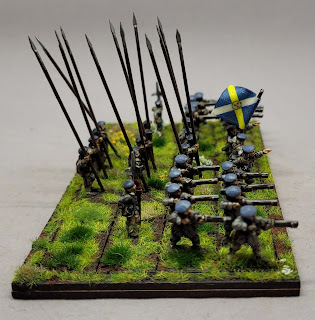Colonel Alexander MacDonnell’s Regiment of Foot
Alexander MacDonnell was the brother of Randal MacDonnell, 1st Marquis of Antrim. The family was a branch (technically called a sept) of the Clan Donald, an historic clan with claims to the title Lord of the Isles. Randal would die without producing an heir and Alexander would go on to become the 3rd Earl of Antrim (Randal was 1st Marquis, 2nd Earl in case you are wondering why it seems as though I have poor numeracy skills).
 |
| The good thing about taking pictures of 15mm figures and looking at them on a big screen is noticing mistakes - the errant pike (back row, left hand side as we view it) has now been repaired. |
When the Regiment was sent to Scotland in 1644, as part of the Irish Brigade, Alexander stayed in Ireland. The Regiment being effectively commanded by Major (later Lieutenant Colonel) Thomas Laghtnan.
The Regiment fought at Tippermuir, mustering 700 men; Aberdeen; Inverlochy; Auldearn; Alford; Kilsyth; and finally at Philiphaugh.
Philiphaugh saw the end of most of the Irish Brigade: with the collapse of the Royalist cause in England, Leslie's Covenanting army returned north to deal with Montrose. Montrose's Army was camped in two separate locations - the force led by O'Cahan and the other Irish divisions who had stayed with Montrose found themselves under surprise attack and hopelessly outnumbered. Montrose tried to go to aid the beleaguered Irish but was fought back and fled.
Leslie offered O'Cahan terms of surrender: If they laid down their arms and agreed to leave Scotland, they would be allowed to go free. O'Cahan agreed. Leslie captured the now unarmed force, and O'Cahan witnessed the execution of virtually his entire army including the camp followers. O'Cahan and Thomas Laghtnan were taken to Edinburgh Castle and hanged from its South Wall without a trial.
The Irish Rebellion continued, and the Regiment was raised anew in 1647: fighting at Benburb; the Kilbeggan mutiny; and the Battle of Scarrifhollis in 1650.
Alexander would be stripped of his land by Cromwell (although he was given a large estate in Connacht as compensation) . Upon the Restoration his Antrim Estates were returned and he was elevated to great office. Alexander would once again find himself on the losing side of a Civil War, throwing his hat in for the cause of James II in the Williamite War.
No highlanders in the mix this time. Although there are a handful of lowland pike, and an 'English' pikeman too. Some fool ordered Irish pike with pike (instead of open hand) and I messed up the hand drilling on a few figures. Quite a few headswaps - mostly the Irish musketeer wearing the pork pie hat. Not so keen on his hat, so a bare head, a few Irish hats, and a blew bonnet.
Flag as always from Maverick Models. Just like the last Irish Regiment we know what the Irish Brigade flags looked like (we have good descriptions), we just don't know who carried which flag, so I picked one of the flags at random. Also shown is their casualty marker.
Update: since discovering the primary source material for the Catholic Confederacy flags (see here) I've reflagged the regiment. Here's what they look like now...















Wonderful regiment. I may have mentioned it before but in case I didn't, I really like the way you have mounted all the shot and pike components of your regiments on the same movement tray.
ReplyDeleteThanks Codsticker. Wanted a Streeter/Sturt look for my RoF. Which is why the musket/pike ratio isn't quite correct. My ratio is 4:3, in reality it was usually 2:1.
DeleteIf I was starting afresh I would probably utilise Simon Miller's TTS/FK&P wiggly edged bases and try and replicate my 'look' on single big bases.